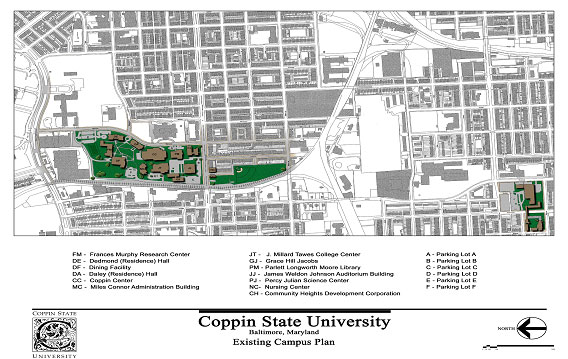









Coppin State University
Baltimore, Maryland
As part of a team under the direction of RJE, AIA, the firm completing a campus-wide facilities master plan for the University that included Dr. Linhart, Mr. Esposito and Mr. Fellingham assessed existing indoor and outdoor athletic, physical education, and recreation facilities of this Division I university relative to current and planned programs. Among the recommendations were the demolition of the current Coppin Center, the physical education facility, and construction of a new Physical Education Center on new property that was acquired and which will allow the University to have much needed athletic and recreation fields for the campus.

In addition to serving as the principal in charge of the campus master planning process, Mr. Esposito, together with Dr. Linhart, completed facilities needs assessments and capital project recommendations for all the remaining academic and administrative units of the University and completed the Facilities Master Plan. A significantly land-locked institution on 38 acres with 10 buildings and no available space for expansion or surge, Coppin State University had to identify its needs comprehensively and plan the sequencing of its capital projects carefully to minimize disruption on campus. Expansion of Coppin's land holdings on both, north and south sides of the main campus was an initial priority, and the opportunities for further land acquisition by the College must be pursued as they arise. Further, most of Coppin's facilities and infrastructure were deficient.
The Facilities Master Plan encompassed and incorporated three precursor planning efforts for the University. First it extended the concepts of campus expansion to the south side of North Avenue presented in the previous Facilities Master Plan and of the creation of a "front porch" for the University to strengthen its mission service ties to the community. It also supported the fundamental organization of the University campus as defined in this previous plan. Secondly, it incorporated the University's response to the goal of the University System of Maryland that each institution has one program of national prominence. Third, it reinforced the recommendations of the Independent Study Team on the revitalization of the University, of which Mr. Esposito was a State appointed member, as articulated in the University's strategic plan. In sum, this Facilities Master Plan represented a natural progression of Coppin State University's campus development, founded on enduring concepts, reinforced through careful, and thoughtful evaluation of needs and issues, and propelled by strong conviction to the promise of Coppin's mission. Overall facility recommendations called for:
- Demolition of 3 buildings-57,897 NASF, 100,827 GSF,
- Construction of 7 buildings-579,225 NASF, 1,044,985 GSF, and
- Renovation of 5 buildings-211,950 NASF, 354,904 GSF,

Subsequently, the ICAC team of Mr. Esposito, Mr. Fellingham, and Dr. Linhart prepared a facilities program for a new Physical Education Center and outdoor recreation and athletic fields. The purpose of this Part 1 Facilities Program Justification was to present to the State of Maryland the need and rationale for the construction of a new Physical Education Complex (107,940 NASF, 189,400 GSF) and an Indoor Track facility (45,500 NASF, 57,000 GSF), relocation of the existing baseball field, and construction of an outdoor track with soccer field, tennis courts, and softball field. In addition to these physical education facilities, parking for building occupants and visitors was included in the project.
Following the completion of the Part 1 program, the ICAC team of Mr. Esposito and Mr. Fellingham completed a Part 2 Specifications document. This document presented the specifications for each individual space and each of the proposed functions/programs, as well as the design guidelines to be used by the architectural and engineering team for the design and construction of the facilities. These design guidelines addressed not only the building but also a complete site plan for utilities, storm drainage ponds, site development, signage, and other infrastructure improvements.
The State of Maryland approved the construction of a new Physical Education Complex including:
- 4 classrooms and 2 class laboratories to support the Health, Physical Education, Recreation, and Dance (HPERD) Department programs,
- offices supporting the HPERD and Athletic Departments,
- shared physical education and intercollegiate athletic facilities, including:
- main arena with seating for approximately 5,000 and 3 basketball courts,
- 4 racquetball courts, 2 multi-purpose recreation spaces, and a 2-court auxiliary gym with storage,
- 8-lane 25-meter competitive pool with seating for 100,
- dance studio (25 capacity) and fitness facility (85 capacity),
- general locker/shower rooms (2), and 2 official and 2 visitor locker rooms, general support facilities, and 4 team rooms to support the ICA program,
- sports medicine facilities, 10 tables and rehabilitation area,
- concession and ticket booths,
- 3 lounges, and
- general building storage and central services,
- 8 lighted tennis courts,
- baseball field,
- softball field, with synthetic turf outfield, bleachers, dugouts, fencing, and lighting, and
- 8 lane, 400-meter track with a field events area, a synthetic turf soccer field, bleachers, and lighting.
Mr. Fellingham then subsequently was hired to provide the equipment list for the entire project. This "fixtures and fittings" list includes all the office furniture, athletic and sports medicine equipment, outdoor facilities' equipment, lighting and spectator seating, scoreboards, timing devices, lockers, and other facility and space-related equipment and furnishing items.
<< Back To Projects